
Aves
Costa Rica has an extraordinary and varied bird gruops, around 860 species in 73 families. Birds are characterized by their ability to fly, their feather covered boies, their melodic snging and for absolutely being the masters of the air. The Caribbean of Costa Rica is one of the most attractive places in the world for birdwatching, the following species stand out:

• Toucanes
They are characterized by their colorful plumage and for having a large light beak. His body and neck are short and thick and have a rounded tail. The Keel-billed Toucan (Ramphastos sulfuratus) is the more striking one because of the color of its beak, measuring around 50 cm., Its plumage is black with white and yellow splashes. They emit a distinctive, peculiar sound. The Chesnut-mandibled Toucan (Ramphastos swainsonii) has a bicolor yellow and brown beak, measuring about 60 cm. The Collared Aracari (Pteroglossus torquatus) measures 38-40 cm., Its beak is black and white, serrated, and black plumage with scarlet and white splashes. The Emerald Toucanet (Aulacorhynchus prasinus), is the smallest, lives in the highlands, their plumage is green, has a blue throat and black and yellow beak.
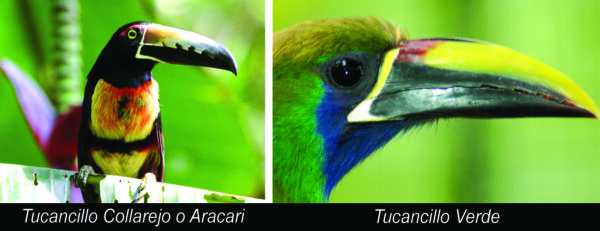
• Parrots
They are brilliant coloured birds such as parrots, cockatoos, parakeets and macaws. The Great Green Macaw (Ara ambigua) has a yellow-green plumage, red forehead, its central feathers and tail blue-green, and its beak is black. It feeds on fruits of various trees, especially in the Mountain Almond where it also nests. In the Caribbean it is found only in the northern zone in the forest´s canopy. Red-lored Parrot (Amazona autumnalis) is primarily green, with red forehead and yellow cheeks. They nest in tree cavities and eats fruits and seeds.
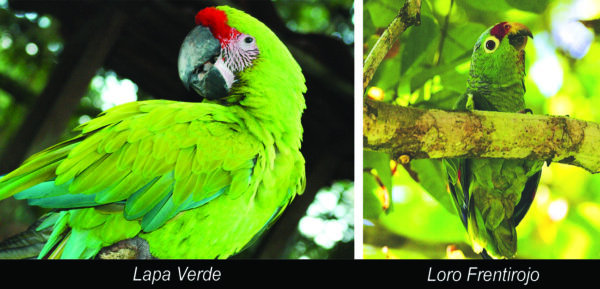
• Woodpecker
Black-cheeked Woodpecker (Melanerpes pucherani) lives in the canopy and the Humid Forest´s boundaries, measures 18.5 cm. and weighs 63 grams, has a red crown and nape, the head´s sides is black and has a white spot near the eye. The body is black with a greyish white in the back, underneath has a light olive colour, and has a gray throat. El Chestnut-Colored Woodpecker (Celeus castaneus) prefers dense forests, measures 23 cm. and weighs 100 grams, its body is brown and its neck and head are ocher, which becomes golden in its crest. They build their nests in holes in the trunk or branches of dead trees. They feed on insects they catch when pecking and exploring the epiphytes barks. They also feed on a wide variety of fruits.

• Hummingbirds
They are the smallest of all birds, with over 50 species, some of them less than 8 cm. in length, displaying bright colors and iridescent green, usually a metallic green. Its beak and tongue is very to suck nectar and small insects which they feed of. They are known for their fast and powerful flattering of its wing, which can move up to 70 times per second, allowing them to remain static in the air. They can visit 500 to 3000 flowers per day and are the only birdsa capable of flying backwards.
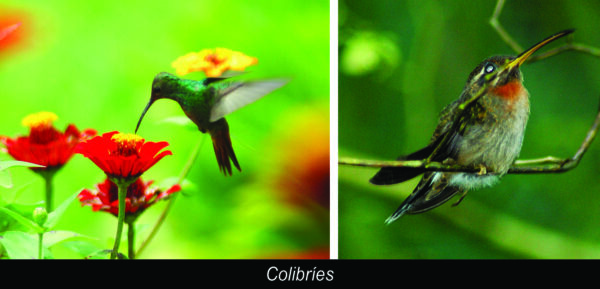
• Trogons
Common name received by 39 bird species which are characterized by their beautiful plumage, and inhabit humid mountain forests. They are cousins of the Quetzal, and have wide, short beak, chipped or serrated, and wide opening. One of the most wanted one is the Baird’s Trogon (Trogon bairdiii).
• Pelicans
The Pelican (Pelecanus occidentalis) is a seabird known for the huge bag under his long beak which is used as fishing net. It is 1 m. long and wehighs around 3 kg. They live in coastal waters, and takes refuge in rocks and trees, nests in colonies and are groups in flocks of 20 or more individuals who coordinatedly fligh in a row.
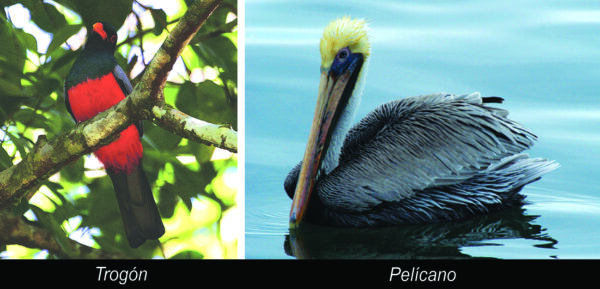
• Anhinga
The Anhinga (Anhinga anhinga) inhabits the rivers, fresh or salt water lagoons and mangroves. They measure 86 cm. and weigh 1.2 kg., its neck is extremely long and thin, have small head, long beak and its wings and tail long and wide. The body plumage is black with silver spots on the wing coverts. It feeds on fish and frogs, and nest in small groups or in larger colonies of other aquatic birds.
• Roseate Spoonbill
The Roseate Spoonbill (Ajaia ajaja) lives in freshwater and salty shallow habitats, such as estuaries and lagoons, mainly in the northern Caribbean. It measures 81 cm. and weighs 1.4 kg., head and beak are spatula – shaped of greenish colour, neck and body is white to pale pink, hot-pink wings with touches of red brick and reddish legs. It feeds by dipping its beak or head into the water.

• Herons
They inhabit fresh or salty water areas, feeding on fish, amphibians and crustaceans. The Great White Egret (Ardea alba) is of white colour, measures 1 meter and weighs 1 kilo, has a yellow beak and black legs. The Snowy Egret (Egretta thula), measures 61 cm. and weighs 313 grams., it has white plumage, black legs and yellow fingers. The Tiger Heron (Tigrisoma mexicanum) measures 80 cm. and weighs 1.2 kg., the crown is black, the sides of head are whitish and neck with black, brown and white stripes. They stay still in the shore for long periods of time, with their necks outstretched waiting for a prey. The Boat-billed Heron (Cochlearius cochlearius) measures 51 cm. and weighs 600 grams., are stocky, have big head, large dark eyes and a huge shoe shaped beak. Forages at night and during the day forms sleeping areas of up to 50 individuals, which are located in tree branches hanging over the water.
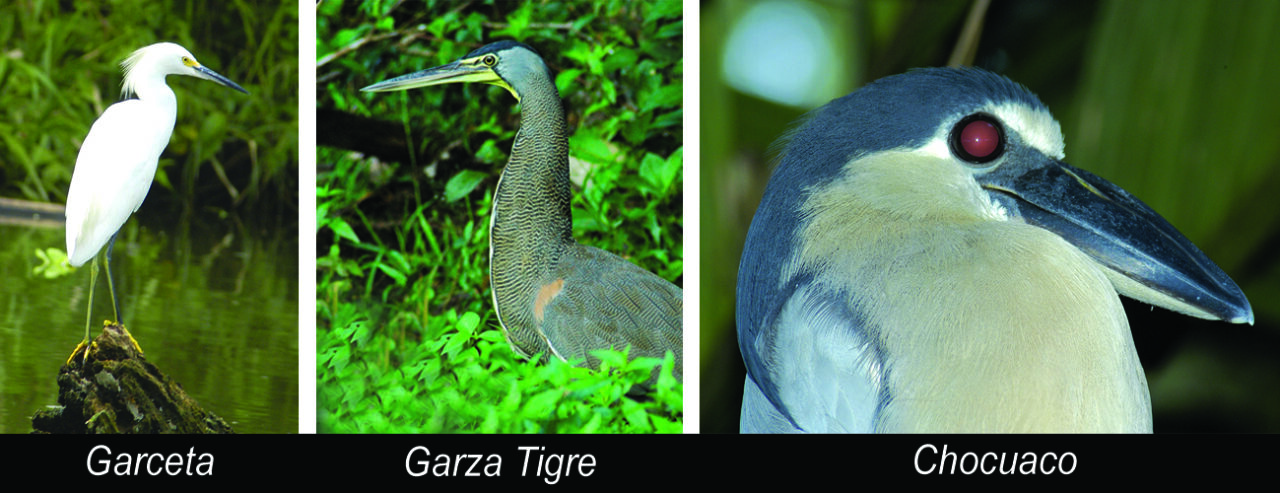
• Jacana
The Jacana (Jacana spinosa) live in aquatic areas with floating plants, measures 23 cm. and weighs 95 grams. In this species, polyandry prevails, the female realtes with several males who are the ones that hatch the eggs. It feeds on insects, small fish, snails and seeds.
• Predatory Birds
One of the most powerful and is almost extinct Harpy Eagle (Harpy arpyja) of 1 meter long and 2 mts of wingpam, lives in the virgin forests of the Talamanca mountain range, feeds on arboreal mammals such as monkeys, sloths and opossums. The Osprey (Pandion haliaetus) abundant in the Caribbean, lives near salty or fresh water areas inhabited by fish that swim near the surface, measures between 52 and 60 cm., with a wingspan of more than 1.5 meters. Spectacled Owl (Pulsatrix oerspicillata) measures 48 cm. and weighs 750 grams., lives inside and in the borders of dense forests, nests in a spacious natural cavity of a tree, hunts at night and feeds on large insects, medium sized mammals, small lizards and birds. And the king of the scavengers is, the White King Vulture (Sarcaramphus papa).
The lowlands of Talamanca are uniquely placed so as to observe the passage of thousands of birds of prey in their migration between breeding grounds in the North and resting places in the South. The migration seasons are from February to May and from August to December, with October being the month with more concentration of these birds. The observation tower on the Indian Reservation Kekoldi (Southern Caribbean) is a privileged place to observe this phenomenon.
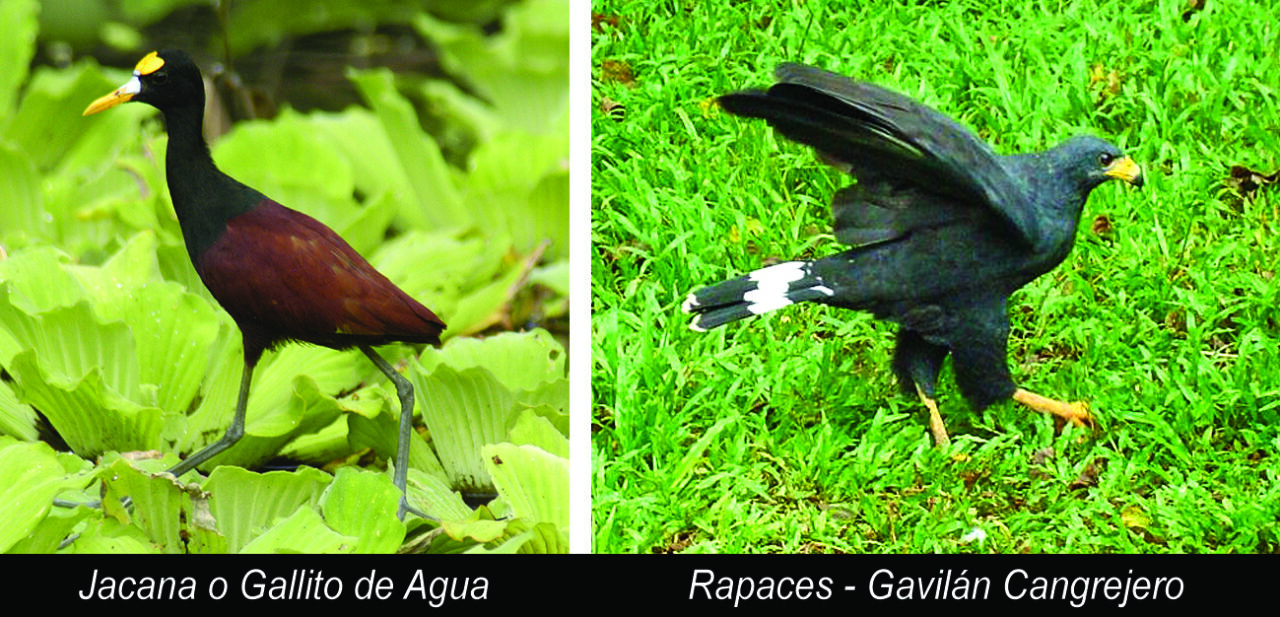

Fotografias de Paco Salmerón
Texto de Juan Carlos Lorite y Paco Salmerón
Diseño de Juan Carlos Lorite